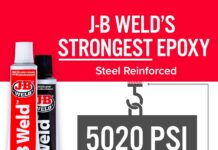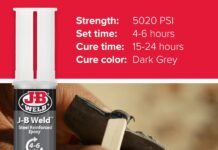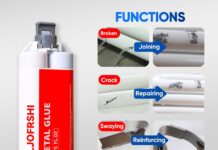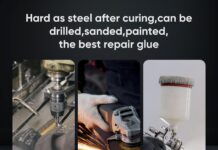Welding is an essential part of pipe fabrication and repair. It requires precision, patience, and the right tools to complete the job correctly.
And when it comes to welding, the equipment you choose will make all the difference in the quality of your work. So what is the best pipe welding tool?
The answer depends on several factors: application, size, and budget. This blog post will explore different types of pipe welding tools and examine which ones are best suited for specific jobs.
We also provide tips on using them safely and effectively to ensure a successful final product.
This article will look at some of the best-chosen Pipe Welding Tools.
We recommend using RIDGID 40220 461 Straight Welding Vise, 1/2-inch to 8-inch Pipe Welding Clamp, Red, Small as reasonably priced.
Read Next – KC MIG Guns For Welding
We aim to provide various pipe welding tools and accessories at competitive prices.
Contact us today for more information about our products or services, including the latest flux-cored arc welding equipment technology.
The Best Pipe Welding Tools
If you’re looking for an expert welder who can weld pipe.
We are the premier provider of welding services in the greater San Antonio area, with experience working on various piping projects.
Whether you need to repair or upgrade your current pipeline system, our team will meet all your needs!
Contact us today, and let’s start crafting solutions that fit your budget and time constraints.
What are the best pipe welding tools?
There are many factors to consider when choosing the best pipe welding tools for your project. The first is the type of welding you will be doing.
Pipe welding can be divided into two main categories: manual and automatic. Manual welding is typically done with a torch, while automatic welding is done with a machine.
The next factor to consider is the material you will be welding. The pipe is typically made from either stainless steel or carbon steel.
Each type of metal has advantages and disadvantages for welding, so choosing the right one for your project is essential.
Stainless steel is more resistant to corrosion and heat but can be more difficult to weld than carbon steel. Carbon steel is easier to weld but isn’t as strong or durable as stainless steel.
Finally, you need to consider the size and shape of the pipe you’re welding. This will determine what kind of welder you need and what size tips and electrodes you’ll need to use.
Smaller pipes can usually be welded with a handheld welder, while larger pipes may require a machine-mounted welder. Selecting the right tools for your project will help ensure success.
What are the different types of pipe welding?
Pipe welding tools can be used to weld different pipe materials, including steel, stainless steel, and aluminum.
Each material has benefits and drawbacks that should be considered when choosing a welding tool.
Steel pipe is the most common type used in construction and manufacturing. It is solid and durable but also susceptible to rust and corrosion. Stainless steel pipe is less likely to corrode than steel pipe but is more expensive.
Aluminum pipe is lightweight and resistant to corrosion, but it is not as strong as steel or stainless steel.
TIG Welding
TIG welding, also known as gas tungsten arc welding (GTAW), is an electrical process that uses a non-consumable tungsten electrode to produce the weld.
The electrode is pointed so that it can be used to create a small, focused arc. This arc then heats the metals being joined to create the weld.
TIG welding is often used for thin materials, producing a clean and robust weld with minimal distortion. It can also be used on dissimilar metals, making it a versatile option for many projects.
TIG welding does require more skill than other types of welding, so it’s essential to receive proper training before attempting this process.
MIG Welding
MIG welding, or Metal Inert Gas welding, is a type of arc welding that uses a wire electrode and an inert gas to weld metal.
The arc’s heat melts the metal, and the gas protects the molten pool from oxidation.
MIG welding is used for many applications, including auto body repair, fabrication, and home repairs. MIG welders are available in various sizes and power levels to suit any project.
When choosing a MIG welder, it’s essential to consider the thickness of the metal you’ll be welding, the amperage requirements, duty cycle, and portability.
With so many market options, choosing the right welder for your needs can be overwhelming. But with some research, you can find the perfect MIG welder for your next project.
Arc Welding
Arc welding is a process that uses electricity to create an arc between an electrode and the metal being welded. The arc heats the metal, which melts and joins together—arc welding welds most metals, including steel, aluminum, and stainless steel.
There are several types of arc welding, including MIG (Inert metal gas) welding, TIG (Inert tungsten gas) welding, and stick welding. Each type of welding has its advantages and disadvantages.
MIG welding is the most common type of arc welding. It is fast, easy to learn, and can be used to weld various metals. TIG welding is more difficult to learn but produces higher-quality welds. Stick welding is the simplest arc welding type but is best suited for thicker metals.
No matter what type of pipe you are working with, there are specific tools that will make your job easier.
For example, a pipe stand will hold the pipe in place while you work, and a chipping hammer will remove any slag from the surface of the weld. A good welder will have all the necessary tools to complete the job.
Flux-Cored Welding
Flux-cored welding is a type of welding that uses a flux-cored wire to weld. This type of welding is often used in applications where there is not enough time to set up an oxygen tank and gas regulator or where it is not possible to use an oxygen tank and gas regulator.
Flux-cored welding is a great alternative to stick welding because it is less likely to cause warping and distortion. It is also easier to control the heat with flux-cored welding, which means you can weld thinner materials without burning them.
There are two types of flux-cored wires: self-shielded and gas-shielded. Self-shielded wires do not require an external gas supply, making them more convenient for portable welding applications.
Gas-shielded wires require an external gas supply but provide better penetration and a cleaner weld bead.
The main disadvantage of flux-cored welding is that it produces more fumes than other types of welding. Be sure to work in a well-ventilated area using this type of welder.
Stick Welding
Welding pipes is a challenging and rewarding activity that can be done with various tools. The best pipe welding tools will depend on the type of pipe being welded, the pipe size, and the desired results.
For example, small-diameter pipes can be welded with a handheld stick welder, while larger-diameter pipes may require a machine-mounted welder.
Pipe welding generally falls into two categories: butt welding and fillet welding. Butt welding is accomplished by joining the ends of two pieces of pipe together so that they are flush. Fillet welding joins the side of one pipe to the side of another. Each type of weld requires different tools and techniques.
Stick welding is a popular form of arc welding that uses an electrode (the “stick”) to create an electric arc between the joined metal surfaces.
The electrode is consumable, which melts during welding to form a pool of molten metal (the weld pool) that joins the two pieces. Stick welding is typically used for thicker metal pipes with thicker walls.
The main advantage of stick welding is that it can be used in almost any position, including vertical and overhead positions. This makes it ideal for Welding pipes in difficult-to-reach places. Another advantage of stick welding is that it is relatively inexpensive compared to other forms of arc welding.
Disadvantages of stick welding include the fact that it requires a lot of skill and practice to master, as well as creating a lot of slags (a residue left after the weld is finished). Stick welding also produces smoke and fumes, so proper ventilation is required.
How to choose a suitable welding machine?
When choosing the suitable welding machine for your needs, there are a few things you need to consider.
The first is the type of welding you’ll be doing. Are you going to be mainly doing pipe welding? If so, you’ll want a machine specifically designed for that purpose.
There are many different types of welding machines on the market, so it’s essential to research and ensure you’re getting the best suited for your needs.
Another thing to consider is the power output of the machine. This is important because you must ensure the machine can handle the type of work you’ll be doing.
A lower-power output machine will suffice if you’re only doing light-duty work. However, if you plan on doing heavier-duty work, you’ll need a machine with a higher power output. Otherwise, you risk damaging your equipment or, worse, injuring yourself.
Finally, you must consider what features you need in a welding machine. Do you need something portable? Or do you need something that has more power and features?
Once again, it all depends on what type of work you’ll be doing and your specific needs. Considering all these things, you should have no problem finding a suitable welding machine.
B&B Pipe 2130 Stepped Pipe Wedge (Small) 3/4" Width x 4" Length for Pipe Fitting Welding
Features
| Part Number | 2130 |
| Model | 2130 |
| Color | White |
| Size | 3/4 in. x 4 in |
Strong Hand Tools CPL45 , Pipe Fit-Up Clamp, Pipe Welding Alignment Tools (Pipe Diameter Capacity: 2″ ~ 4″ (50~100 mm))
$90.72 in stock
Features
| Part Number | CPL45 |
| Model | CPL45 |
| Color | Metallic |
Jackson Safety Pipe Measure Tool Wrap Around Tape, Flex Angle Measuring and Marking Gauge for 3 to 6 Diameter, Medium, Black, 14752, 3.88" X 4''
Features
| Part Number | 14752 |
| Model | 14752 |
| Color | Grey |
| Size | 3.88" X 4' |
Monster & Master Welding Pipe Plier, Fast Release, C-Clamp Locking with Large V-Pads, 10-Inch, ATHUS-MM-WLP-S9
Hayes Digital Socket Fusion Pipe Welder Tool Complete Kit PRO (up to 2 in.)
Features
| Part Number | HY2CKIT |
| Model | HY-2COMP |
| Color | Orange |
| Size | 2 Inch |
JIAWANSHUN Plastic Water Pipe Welder 110V Plastic pipe welding tool PP/PP-R/PE/PP-C Pipe Welding Machine with 0.79/0.98/1.26/1.57/1.97/2.46in Die Head (M63)
$49.98 in stock
Features
| Part Number | CJ031 |
| Model | CJ031 |
| Color | M63 |
Welding Pipe Clamps 10-Inch Welding Pipe Pliers, Fast Release, C-Clamps Locking with Large V-Pads, welding tools and accessories (2 Pack)
Features
| Part Number | CIPCO PRO TOOL |
| Model | CIPCO PRO TOOL |
| Color | Chrome |
Jewel 1A Pipe Welding Clamp
Features
| Part Number | 1A |
| Model | 1A |
| Color | Red |
4 Pieces Copper Pipe Cleaner and Reamer Set Inner-Outer Reamer Pipe and Tube Deburring Reamer Tubing Chamfer Tool for PVC PPR Copper Brass Aluminum Pipes
$13.99 in stock
Features
| Part Number | Honoson-Pipe-S7883 |
| Model | Honoson-Pipe-S7883 |
6" Pipe Pliers, Two Fixed V-Pads, Throat Depth: 2″ (50 mm), MAX Clamping Capacity: 1″ – 2″ (25 – 50 mm), Thread: M8, PG622V, Strong Hand Tools
Features
| Part Number | VAL-PG622V |
| Model | PG622V |
| Color | Silver |
| Size | 1 Pack |
Strong Hand Tools - STRONG - PG114V Strong hand Tools PG114V Pipe Pliers with Large V-Pads, 11-Inch
Features
| Part Number | STRONG - PG114V |
| Model | STRONG - PG114V |
| Color | Chrome |
| Size | 11-Inch |
B&B Pipe 1220 PDQ Pipe Clamp (Small) fits 1" to 3" Pipe for Pipe Fitting, Fit Up, and Welding (One Pack)
Features
| Part Number | 1220 |
| Color | Multicolor |





























































